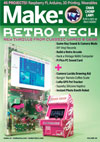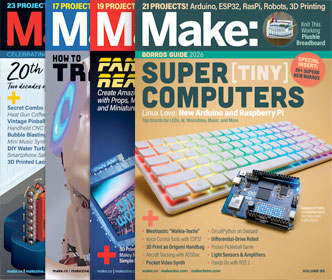
Here’s yet another delightful mechanical curiosity from among Nikola Tesla’s 278 known patents. This one is #1,329,559 US, “Valvular Conduit,” issued 1920. You may have to stare at the upper section, for a moment, to figure out what’s going on: Flow from left to right, as illustrated, is against the valve’s bias—the stream is broken up and diverted in circular paths that return to interfere with each other. Flow from right to left, however, is not so impeded.
These are images of a laser-sintered nylon Tesla valve by Shapeways user imperator, who is also, I believe, the narrator in this video from YouTuber LimitlessInd.

It includes a brief demonstration of the conduit’s operation in both directions (using a stream of air from the narrator’s mouth), but I for one would love to see a demo using a visible fluid. YouTuber vitglow has posted some animations based on simulated flow in a Tesla valve in both easy and hard directions, but I haven’t found any other moving pictures.
Boston Thingiverse user Brendan Chenelle has posted a 3D model.
The design is amenable to “nano” manufacturing techniques, and has attracted interest among researchers in microfluidics. I am left wondering about fully 3D implementations of the same idea, where the “hard” pathways branch outside the plane and/or are multiply divergent.
27 thoughts on “The Tesla Valve: One Way Flow With No Moving Parts”
Comments are closed.
ADVERTISEMENT
Join Make: Community Today













This is amazing. I’ve experienced something similar to this when cleaning out small, U-shaped tubes in a faucet. If you aim the faucet stream down one end of the tube, it comes squirting up the other side. If you aim that second stream at the first stream, it knocks it out of the way and impedes it for a moment.
Fluidic valves with no moving parts have been used in the Nuclear industry for some years.
Thanks, no doubt, to J. Edgar Hoover stealing Tesla’s designs when he died!
Yes, though those I have seen are switching valves (i.e. not check valves) that use the Coanda effect to divert flow from one output path to another without any moving parts or joints that can leak (potentially radioactive) fluid.
Reminds me of http://en.wikipedia.org/wiki/Vortex_tube
Another simple yet facinating device
Another beautiful mechanical engineering device is the Vortex Tube: http://en.wikipedia.org/wiki/Vortex_tube
Compressed air goes in, hot air comes out one side, cold air out the other.
These have been used in manufacturing for quite a few years, now. My cousin used to weld in operating blast furnaces in a space suit that was cooled by a Vortex tube.
The Valvular Conduit was originally designed by Tesla to be used as an inlets for the combustion chamber that ran his Tesla Disc Turbine. With one for fuel, and one for air, the conduits were easily adjustable for optimum air/fuel ratio…so any fuel could be used!
It seems with CFD analysis, CAM manufacturing, and modern materials, the Valvular Conduit could replace the valves in an IC engine…or at least run a modern Tesla Turbine the way it was originally conceived.
Thank you for the mention and link! I am the one who made the Tesla Valve you have the pictures and video of. The world of no moving parts really amazes me. I’m currently working on a new type of jet engine with no moving parts, inspired by my work on the Tesla Valve.
I really do need a video with some visible gas or liquid. It would demonstrate how effectively those hooked regions restrain flow. I’ve been thinking of building a setup with a clear acrylic sheet so you can look into the device as it operates.
The reason I built this Tesla Valve was that I had always admired the elegance of Tesla’s work, and wanted to have one of his devices. 3D printing made it a breeze to make.
Thanks again,
Adrian Perez
I’d like to see that. Maybe just some water with food coloring and do a time/volume comparison for each direction?
Adrian,
It is very intersting that you say that. In highschool I attempted to make a pulse jet engine utilizing two tesla valves and propane as a fuel. The device was only a proof of concept, and worked marginally well, with sustained pulses but very very limited thrust. It was also very sensitive.
I have always thought about revisiting the project now that I am much older and have more tools and experience. I think the failing in the original device was the limited number of valves; My later idea had an array of many small tesla valves on the front of the engine. This would reduce intake restriction, and the location could be used as an “air ram” feature. I would love to throw some ideas around with you sometime.
I guess this could be considered a fluidics diode, to go with the fluidics logic gates I used to read about (I think they used the Coanda effect). I’m sure there has been some advance in fluidics in the decades since then. Anyway, as I recall, exact shapes and dimensions are important in these devices. I’m wondering about a tube made of stacked vortex disks….
This could be made by micro and nano techniques but the diode effect is unlikely to scale down, because at small dimensions and with viscous fluids you have laminar flow where the streamlines are reversible.
Shouldn’t matter, as I see it. But don’t take my word for it, check the linked paper on simulation and optimization of Tesla valves specifically for microscale applications:
http://www.nsti.org/procs/Nanotech2003v1/9/M72.05
Yes, it is in the paper but at Reynolds numbers of 1 or less it gets weird, the optimal length L of the side tubes becomes less than or equal to the channel width w making it not look much like a tesla valve anymore. you could maybe make a tiny device work at very high flow rates, with gases. It is a great application for 3d printing, nice find!
If you think that paper is interesting. You might also like this one, which uses computerized optimization to create some peculiar tesla valve shapes. http://www.senlin41.org/topology-optimization-of-tesla-type-microvalve/
Thanks, Adrian. That’s exactly the sort of thing I was wondering about. Great read, with great figures.
Oh man! I love it!
That’s a fish heart. No doubt. Nature rocks :D
Which raises a possibly interesting idea: If you made one of these out of an elastomeric material and alternately compressed and released in mechanically, wouldn’t it pump fluid in the “easy” direction?
get access to a 3d printer and find out
Sean,
I do not recall where, but I have seen a small tesla valve used in exactly this way, as a small pump, I believe for implantation.
Thanks, Brendan. That’s a relief to hear, actually, whenever I have a screwball idea: Somebody’s already doing it, which means I don’t have to. My list of screwball ideas to follow up on is already way, way too long. =]
Alter the cavities, add some holes, and you might be able to create a new type of flute with more range and resonance. This is also flat, wonder how much better a 3D model would be and the different models that could be made with different chamber sizes and locations.
I have created a video of a Tesla valvular conduit machined from aluminium. It can be found here…. ://youtu.be/XhJtSqLz88Q
It’s mesmerising to watch this working. I’ve noted a 20% difference in pressure drop from one side to another. I’d love to hear from anyone else interested in seeing this or who has tested one, or who would like to obtain cad data to produce their own through rapid prototyping.
Cool beans!
https://youtu.be/_1UUKiCEs_Y
Here is a video of a tubular tesla valve or valvular conduit thay could be fitted inside a pipe!